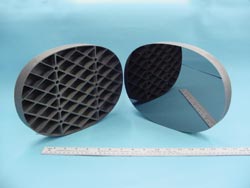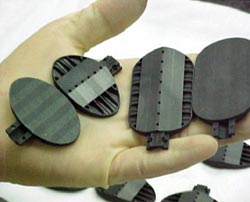A chemical conversion process is enabling the production of lightweight, lower-cost, complex parts for optical systems.
Richard Gaughan, Contributing Editor
NASA systems designers are always looking to minimize mass on solar system exploration projects because every gram comes at a stiff price. When they found a lightweight material that could be used to manufacture the structure and mirror substrates in a single integrated system, they jumped at the chance. The material of choice? Silicon carbide.
Silicon carbide (SiC) has not only a better strength-to-weight ratio than beryllium, but also the unusual combination of high thermal conductivity and low thermal expansion. This combination allows the fabrication of very thin, stiff mirrors that are much lighter than is possible with any other material.

A chemical conversion process promises to make silicon carbide the material of choice for lightweight optical components.
The thermal properties enable SiC systems to maintain their optical properties over a wide range of temperatures, even from room temperature to 77 K. And the material is strong enough to be used to construct an entire optical system — mirror substrates, metering structure and enclosure. Gregg Vane, program manager of the Jet Propulsion Laboratory’s Office of Competed Missions and Science Instruments in Pasadena, Calif., said SiC’s high specific stiffness “allows us to make parts smaller and lighter than [is possible with] aluminum.”
A miniature integrated camera spectrometer (Micas) combined an ultraviolet imaging spectrometer, an infrared imaging spectrometer and two visible-light cameras in a sensor system constructed from SiC. The instrument was spaceflight-tested on the first mission in NASA’s New Millennium Program, Deep Space 1. Besides providing close-up images of an asteroid and a comet, it saved the mission by filling in for a failed star tracker.
The success didn’t come as a surprise to Vane. “During thermal testing, we brought Micas down to ‘cold soak’ at its anticipated in-flight operating temperature. We expected that, once the system reached equilibrium, its optical properties would stabilize. What happened was it remained rock solid throughout the temperature cycling. Excellent dimensional stability allowed Micas to be designed without focus- and alignment-adjustment mechanisms, another significant cost and weight savings.”

Silicon carbide offers excellent thermal and mechanical properties to the optical system designer, but traditional manufacturing methods are expensive, time-consuming and incapable of producing complex parts. A new process makes it possible to produce complex parts such as these in easily machined graphite, then converts them to silicon carbide.
With a success like this on SiC’s track record, why aren’t systems made with this material more prevalent? In a word: manufacturability.
SiC may be produced in a variety of ways. It can be prepared as a chemical slurry and heated in a mold; powdered, pressed and heated; or produced by chemical vapor deposition. Unfortunately, SiC parts fabricated in molds are subject to variable and unpredictable shrinkage. And although chemical vapor deposition is accurate, it takes hundreds of hours to make a single part of relatively simple design. SiC formed by any of these methods must then be machined, but the only process suitable for producing optical surfaces in SiC is diamond turning, again time-consuming and expensive.
David Rodgers, the system designer for the lightweight Pluto mission, said that the manufacture of large-scale SiC optics is a cost issue. So SiC has been restricted to uses for which the excellent mechanical and thermal properties are important enough to balance considerations of cost and schedule. A new process for producing SiC is poised to change that balance.
Conversion process
Poco Graphite Inc. of Decatur, Texas, has developed a chemical conversion process that promises to make SiC the material of choice for many new applications. The conversion operation begins with a block of special-grade synthetic graphite, which is machined to the final configuration. In a proprietary process, it is infiltrated with a silicon-carrying species and heated to a temperature beneath the sintering one used in other manufacturing methods, resulting in a premachined SiC part.
Wayne Hambek, an applications engineer with Poco Graphite, believes that the company’s process “is the right solution for general use because it provides users the ability to manufacture very stiff, lightweight components in shorter cycle time, at lower cost and with much greater design flexibility.” In combination with patent-pending conversion bonding, the process can produce blind holes, hollow structures and other complex design configurations that “cannot be achieved in any other current technology.”
A final SiC deposition produces an optical surface ready for figuring. Aspheres manufactured with this process were machined in graphite to within 0.0003 inches, resulting in a SiC part within 0.002 to 0.008 inches of design. SiC chemical vapor deposition and final polishing created finished parts with 2- to 3-Å smoothness. Mirrors as large as 20 inches in diameter have been produced using the process.
Hambek said that SiC made with the process is ideally suited for optical systems, which take maximum advantage of the design attributes. For example, it allows reduced total weight in space-based or tactical electro-optical sensor systems, or reduced moment about the axis of a high-speed galvanometer.
There is no inherent limitation on the size of parts produced, but the current facility is limited to a maximum of 20 × 40 inches. Because there are no molds, no expensive tools and minimal machining, the process keeps costs down while providing extreme design flexibility. Hambek summarized, “We allow users freedom to design very complex systems, at lower cost and with faster cycle time.”
This may be an opportune time for a new, efficient manufacturing process to emerge. When NASA’s Vane was asked if the agency might consider flying future systems built from SiC, he responded, “ ‘Might’ is not the right word. We will be.”